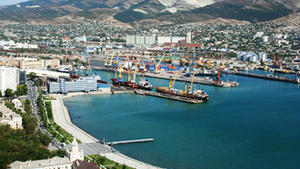Port securityPorts unprepared for increase in Katrina-like storms
A recent report by Stanford University researchers found that the majority of seaports around the world are unprepared for rising sea levels and increasingly violent storms; a majority of ports surveyed listed sea level rise and increasing extreme storms as some of their top concerns; only 6 percent of respondents said they have plans to build hurricane barriers in the next ten years, and less than 18 percent said they had plans to build dikes or other storm protection structures; to ease uncertainty among port authorities, researchers developed a computer model to provide cost estimates that take into account a port’s specific location as well as the cost of labor, materials, and equipment for fortifying a structure against rising sea levels

Russia's Novorossiysk has done no sea-level-rise defense // Source: rt.com
A recent report by Stanford University researchers found that the majority of seaports around the world are unprepared for rising sea levels and increasingly violent storms.
The study, led by Austin Becker, a graduate student at Stanford’s Environment and Resources program, reveals that most port officials are unsure of how to protect their facilities from the more frequent occurrences of Hurricane Katrina-size storms and rising sea levels. Becker explains that the uncertainty in how much sea levels will rise makes planning difficult.
“Part of the problem is that science says that by 2100, we’ll experience anywhere from 1.5 to 6 feet of sea level rise,” he said. “That’s a huge range.”
Building port structures are costly endeavors and therefore require rigid planning and concrete cost estimates, however without accurate information, engineers cannot plan accordingly.
Becker said that building a structure to withstand six feet of sea level rise would be much more expensive and require much greater effort than constructing something to withstand 1.5 feet of sea level rise.
Of the 160 port authorities surveyed, ninety-three agencies responded and a majority listed sea level rise and increasing extreme storms as some of their top concerns. But only 6 percent of respondents said they have plans to build hurricane barriers in the next ten years, and less than 18 percent said they had plans to build dikes or other storm protection structures.
According to Becker, the number of category four and five hurricanes is projected to double in the Atlantic Ocean by 2100, wreaking havoc on existing port structures.
“As we saw with Katrina in 2005, storm and flood damage can devastate a regional economy for years after an event and have national impacts,” he said.
Hurricane Katrina, a category five, caused an estimated $1.7 billion in damages to Louisiana’s ports, and last month the region was hit by severe flooding from the Mississippi River.
To help port authorities plan for the future and build more resilient structures, Becker and his have developed computer models that can provide accurate information on adapting structures to rising sea levels.
Using Google Earth as a platform, researchers have developed a model, dubbed Sebastian, which takes into account the shape of the ocean floor beneath 200 of the world’s most active seaports. With Sebastian researchers are able to provide cost estimates to port authorities that take into account location as well as the cost of labor, materials, and equipment for fortifying a structure against rising sea levels.
Martin Fischer, the report’s co-author and the director of Stanford’s Center for Integrated Facility Engineering, said, “Sebastian allows us to run different scenarios based on different levels of sea rise, and see how the ports are affected.”
The computer model was developed using construction criteria outlined in the Army Corps of Engineers manual.
Fischer added that the Sebastian helps provide a macroscopic view of worldwide demand for resources as well as an in depth look at a specific site, providing port authorities with an idea of how much protection they are adding with various protective structures.
Due to the long life-span of port structures, Fischer says it is critical that engineers take into account future changes in the environment when building facilities.
“Look around at any seaport today and you will see structures that were built 100 years ago,” he said. “And the buildings that we are building today will be around when sea level rise begins to reshape the coast.”
But Fischer warned that if ports around the world simultaneously began revamping their facilities to withstand severe storms and rising sea levels, prices for labor, equipment, and construction materials could dramatically increase.
In addition this global construction scramble “could potentially exceed our capacity for construction worldwide,” he said.
